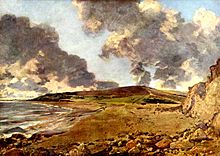Weymouth Bay
Boundary
When Natural England looked at access to Weymouth Bay prior to the 2012 Olympic Games, they defined it as the stretch between Rufus Castle on the Isle of Portland and Lulworth Cove, an area which covers Portland Harbour, Weymouth Beach, and Ringstead Bay.
Sailing
The bay's waters are excellent for sailing — the best sailing waters in northern Europe, in part because the bay is sheltered from south-west winds. This means that Portland Bill can be accessed easily from anywhere on Weymouth Bay by sailing when the tide is turning as an eddy flows along Portland's eastern side.
The bay is home to the Weymouth and Portland National Sailing Academy and hosted the sailing events for the 2012 Olympic Games. Since the games, the Academy's venue has continued to improve to ensure a "legacy" for the Olympic Games.
Painting

Weymouth Bay: Bowleaze Cove and Jordon Hill was painted by the leading English landscape artist John Constable in 1816–17. Constable had honeymooned on the south coast in October 1816, inspiring the painting. The painting now hangs in the National Gallery, London.
References
- ^ "Coastal Access - Weymouth Bay" (PDF). Natural England. Retrieved 26 August 2016.
- ^ "2012 Olympic Games sailing venue". Weymouth and Portland Borough Council. 2005. Archived from the original on 27 September 2006. Retrieved 12 November 2006.
- ^ Endean, Ken (7 September 2013). Yachting Monthly's Channel Havens: The Secret Inlets and Secluded Anchorages of the Channel. A&C Black. p. 33. ISBN 9781472901668.
- ^ Peace, Alex (22 August 2016). "LEGACY - Olympic report praises projects and initiatives in Weymouth and Portland". Dorset Echo. Retrieved 26 August 2016.
- ^ Constable, John (2 September 2015). Delphi Collected Works of John Constable (Illustrated). Delphi Classics.